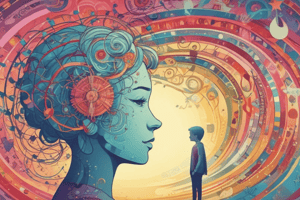Podcast
Questions and Answers
What are the stages of cognitive development proposed by Jean Piaget?
What are the stages of cognitive development proposed by Jean Piaget?
The stages are Sensorimotor, Pre-operational, Concrete, and Formal Operational.
What is the main process by which Piaget believed children transition from one cognitive stage to another?
What is the main process by which Piaget believed children transition from one cognitive stage to another?
The process involves adaptation and the pursuit of equilibrium.
Describe the characteristics of the Pre-operational stage in Piaget's theory.
Describe the characteristics of the Pre-operational stage in Piaget's theory.
In the Pre-operational stage, children exhibit egocentrism, intuitive thinking, and growth in language.
What key abilities develop during the Concrete Operational stage according to Piaget?
What key abilities develop during the Concrete Operational stage according to Piaget?
How does the Heinz dilemma relate to Piaget's theory of moral development?
How does the Heinz dilemma relate to Piaget's theory of moral development?
What was a key contribution of Lawrence Kohlberg to psychology?
What was a key contribution of Lawrence Kohlberg to psychology?
What characterizes the pre-conventional level of Kohlberg's moral development?
What characterizes the pre-conventional level of Kohlberg's moral development?
How does the conventional level of moral reasoning differ from the pre-conventional level?
How does the conventional level of moral reasoning differ from the pre-conventional level?
What is the main challenge faced during the Trust vs Mistrust stage of psychosocial development?
What is the main challenge faced during the Trust vs Mistrust stage of psychosocial development?
During the Initiative vs Guilt stage, what skill do children learn?
During the Initiative vs Guilt stage, what skill do children learn?
What is the role of proprioceptors?
What is the role of proprioceptors?
What can lead to an identity crisis during the Identity vs Confusion stage?
What can lead to an identity crisis during the Identity vs Confusion stage?
What is the outcome of the Generativity vs Stagnation stage?
What is the outcome of the Generativity vs Stagnation stage?
What is the threshold in the context of sensory perception?
What is the threshold in the context of sensory perception?
What types of light receptors are found in the human eye, and what are their functions?
What types of light receptors are found in the human eye, and what are their functions?
What is the Fovea Centralis?
What is the Fovea Centralis?
What is myopia and how does it affect vision?
What is myopia and how does it affect vision?
What is dark adaptation?
What is dark adaptation?
How do complementary colors relate to color perception?
How do complementary colors relate to color perception?
What is the difference between positive and negative afterimages?
What is the difference between positive and negative afterimages?
What are dichromats and how do they differ from trichromats?
What are dichromats and how do they differ from trichromats?
Flashcards are hidden until you start studying
Study Notes
Jean Piaget's Cognitive Development Theory
- Piaget proposed a theory based on intellectual development and how adaptation to the environment occurs through progressive stages.
- He focused on cognitive development in children and aimed to study their overall development using a set of discrete stages.
- He believed that intelligence is not a fixed quantity, and intellectual growth stems from adaptation and a constant need to be in a state of equilibrium.
- Schemas are the building blocks of knowledge and the process to allow one stage to transition into the next.
Stages of Development
- Sensorimotor Stage (0-2 years old)
- Children interact actively with their environment during this stage.
- They coordinate motor skills with sensory experiences.
- The concept of object permanence develops which means understanding that objects exist even when they are not visible.
- Pre-operational Stage (2-7 years old)
- Characterized by egocentrism or self-centeredness.
- Children attribute human-like qualities to inanimate objects or animism.
- They tend to use intuition rather than logic to solve problems.
- Language skills improve rapidly during this stage.
- Concrete Operational Stage (7-11 years old)
- Children develop the ability to conserve or understand that the quantity of an object remains the same even if its appearance changes.
- They achieve reversibility of thoughts, meaning they can mentally reverse a sequence of steps.
- They gain a grasp of numbers and mathematical concepts.
- Formal Operational Stage (11-15 years old)
- The ability to think abstractly and hypothetically.
- They can engage in propositional thinking, which involves evaluating logical statements.
- There may be increased idealism.
Lawrence Kohlberg's Theory of Moral Development
- Kohlberg developed a theory of moral development based on the progression of moral reasoning.
- He identified three levels of moral reasoning:
- Pre-Conventional Level (Young Children): Moral judgments are based on obtaining rewards and avoiding punishment.
- Conventional Level (Older Children and Adolescents): Moral decisions are influenced by what others might think of them.
- Post-Conventional Level (Adults): Moral judgments are based on ethical principles and a sense of justice.
Psychosocial Stages of Development (Erik Erikson)
- Trust vs Mistrust (Birth to 1 Year): Infants develop a sense of trust or mistrust based on their interactions with caregivers.
- Autonomy vs Shame & Doubt (1-3 Years): Toddlers gain independence and learn to control their bodies and environment, or they may develop feelings of shame and doubt.
- Initiative vs Guilt (3-6 Years): Children learn to take initiative and try new things, or they may develop feelings of guilt over their desires and actions.
- Industry vs Inferiority (6-12 Years): Children learn to master academic and social skills or develop a sense of inferiority when they feel inadequate.
- Identity vs Confusion (12-20 Years): Adolescents explore their identity and roles in the world, or they may experience confusion and struggle with their sense of self.
- Intimacy vs Isolation (20-40 Years): Young adults form meaningful relationships, or they may feel isolated and alone.
- Generativity vs Stagnation (40-65 Years): Adults find purpose and meaning in contributing to society, or they may feel stagnant and unfulfilled.
- Integrity vs Despair (65 and Up): Elderly individuals reflect on their lives and find satisfaction or face despair and regrets.
Sensation
- Arises when any of the sense organs are stimulated.
- Receptors: Specialized cells that respond to a specific stimulus.
- Exteroceptors: Found on the outer surface of the body, stimulated by external stimuli.
- Interoceptors: Located in the viscera, respond to internal stimuli from organs.
- Proprioceptors: Found in muscles, tendons, and joints, respond to body movement.
- Threshold: The minimum amount of stimulus needed to trigger a response.
Vision
- The eye is sensitive to wavelengths in the range of 400-800 millimicrons.
- Human Eye: Consists of three layers:
- Sclerotic Coat: The outermost layer, providing structural support.
- Choroid Coat: The middle layer, containing blood vessels that nourish the eye.
- Retina: The innermost layer, where light is converted into nerve impulses.
Light Receptors
- Rods: Sensitive to light and responsible for vision in low light conditions.
- Cones: Sensitive to color and normal light intensities.
- Fovea Centralis: The area with the clearest vision.
- Blind Spot: The point where the optic nerve leaves the eye, devoid of rods and cones, creating an area insensitive to light.
Visual Deficiencies
- Myopia: Nearsightedness (inability to see distant objects clearly).
- Hyperopia: Farsightedness (inability to see near objects clearly).
- Presbyopia: Age-related gradual loss of the eye's ability to focus on near objects.
- Astigmatism: Blurred vision due to an irregular curvature of the cornea.
- Retinal Disparity: The difference in images received by each eye when focusing on an object, contributing to depth perception.
Other Visual Phenomena
- Dark Adaptation: The process of adjusting to low light conditions.
- Purkinje Phenomenon: A shift in the relative brightness of colors as the intensity of illumination changes.
- Color: A perceptual experience comprising hue, brightness, and saturation.
- Hue: The perceived dimension of color, such as red, blue, green (dominant wavelength).
- Brightness: Related to the intensity of the stimulus (amount of light).
- Saturation: The purity of the hue.
Theories of Color Vision
- Young-Helmholtz Theory (1852): States that there are three types of color receptors (red, green, and blue) that combine to produce different colors.
- Hering Theory (1874): Proposed that there are four basic colors based on two opposing processes: red-green and blue-yellow.
- Ladd-Franklin Theory (1892): Suggested that color vision evolved in stages, with black-white perception being the first, followed by blue-yellow, and finally red-green.
Studying That Suits You
Use AI to generate personalized quizzes and flashcards to suit your learning preferences.




